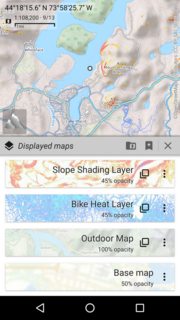Trail Boss
New member
Just like different models of PLB, different models of phones can vary in GPS performance. Case in point:...A friend and I compared the GPS tracks from his iphone 4s and my Garmin 60CSx: the iphone track had significant excursions from our (known) route, the 60CSx did not. (The walk was under trees, but terrain was not a problem.) Also a phone GPS drains a battery that may be needed for communication...
I have a Garmin Rino 530HCx. It's the same vintage as the Garmin GPSMAP 60CSx (circa 2007). I performed extensive testing in a local forest (~30-40' canopy of mature maples), comparing four GPS apps on my late-model phone. My Garmin served as the "gold standard".
Here's what the phone did. This is eight laps around a ~2 kilometer circuit. Two laps for each of the four apps.

The Garmin recorded all 8 laps. Here's what the "gold standard" did:

Subsequent field tests in the Adirondacks demonstrated the phone's track deviated from the "true path" about as often as the 530 HCx. However, the deviations were well within the range of GPS accuracy. I've found it to be more than adequate for general navigation and trip statistics. My friend used a Garmin 76CS for years and recently switched to using Gaia with his iPhone 5s. He reports the same level of satisfactory performance as with the old 76cs.
As for loss of GPS fix, yes, it can happen, but re-acquisition is fast. In practice, it hasn't proven to be a problem. Honestly, I've only noticed it once and that was during my last hiking trip (the first time in dozens of trips). It appeared as a straight-line segment in my track, running for several meters. For general trail-walking in the mountains, it works fine.
+1...the most cost-effective solution to "I don't know where I am" problem is a phone app that can download maps for off-line use...
Phones are so ubiquitous that it's disheartening to hear when someone gets "lost" with one. Sure, they ought to have a map, compass, skillz, etc but all they'll probably have is their phone. A navigation app, an offline map, and an hour learning how to use it, will at least tell you which way to get back on the trail and out to the road.
Gets better even faster if more people get involved.... I don't dispute that OSM coverage is spotty in some places but I think it is getting better every day.
To all those who know the area forwards and backwards, I suggest you get a free OpenStreetMap account and share your knowledge. FWIW, for the past year I've been enhancing OSM's data for the Adirondack High Peaks region. I post my changes in ADKhighpeaks.com so others in the community (who have even greater familiarity with area) can give me feedback. I also hope it inspires others to contribute.
It's important to know that OSM serves as the source for other maps. Maps you may be using, but aren't aware they are created from OSM data.
Suunto Movescount
GAIA GPS
Thunder Forest Outdoors (in Caltopo)
Waymarked Hiking Trails
BRouter (a routing engine that works with OSM data)
etc
If you don't have the time or inclination to do mapping, please consider just uploading your (clean) GPS tracks to OSM. When a map editor selects an area to work on, she can optionally request to download all publically-available GPS tracks (for the area). Seeing umpteen, closely-spaced tracks snaking up a mountain is the best resource for drawing a trail to within meters of its true location.
PS
@iAmKrzys
Haha! Just found your moniker in OpenStreetMap! You're definitely no stranger to OSM!
Last edited:




